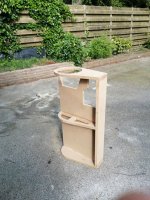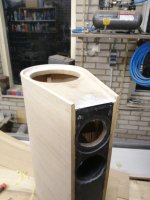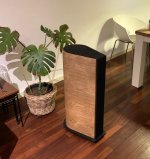Welcome to this thread about the speakers i'm currently building.
This is my second speaker design/build that i have done.
The goals of the build are as follows:
which one should i do?
speakers from top to bottom:
Dayton Audio Reference RS225-8 Bass-midwoofer
Dayton Audio DC28F-8 1-1/8'' Silk Dome Tweeter
Dayton Audio PC105-8 4" full range woofer

This is my second speaker design/build that i have done.
The goals of the build are as follows:
- High Wife Acceptance Factor.
- Should not look like a dull ordinary box.
- Have a nice flat frequency response.
which one should i do?
- passive crossover
- active crossover
- active system with 6 amps and DSP as a crossover
speakers from top to bottom:
Dayton Audio Reference RS225-8 Bass-midwoofer
Dayton Audio DC28F-8 1-1/8'' Silk Dome Tweeter
Dayton Audio PC105-8 4" full range woofer
Attachments
Last edited:
Looks great!
I really like the Hypex active modules. Reasonably priced and absolute High End sound quality. You could also purchase the electronic parts and build your own amp housing for a cental HiFi piece and use Speakon 8pol for the connection. These metal Speakons are of VERY good quality.
I really like the Hypex active modules. Reasonably priced and absolute High End sound quality. You could also purchase the electronic parts and build your own amp housing for a cental HiFi piece and use Speakon 8pol for the connection. These metal Speakons are of VERY good quality.
Wow! That looks amazing!
How did you bend the wood so tightly and what sort of wood did you use?
How did you bend the wood so tightly and what sort of wood did you use?
How did you bend the wood so tightly and what sort of wood did you use?
For the materials i used 3 layers of 3 mm 3-layer plywood.
The bending was the hardest part of the build. bending by hand was tough, because i only have two hands and the wood was pretty stiff.
I soaked the part that gets bend (the middels part of the plywood sheet) in hot water. Then used my moms hot iron to "steam bend" the layer around the frame with glue between the layer and the frame. I held the layer in place with a lot of screws, temporarily, so i can remove them before applying the next layer. Then i did the other two layers the same way but with wood glue in between and drying after every layer for a few days.
thanks for the tip! looks like an easy and timesaving solution.I really like the Hypex active modules.
I'm already developing a discrete amplifier. >100W opamp based amp
So maybe 6 modules and a DSP would be fun.
I went through all three paths. The most flexible and universal solution turned out to be active system with 6 amps and DSP as a crossover, and I abandoned the analog input, which made it possible to implement a very compact solution in the form of a powerful DAC with DSP.I would love to hear your stories and reasons to choose one of these solutions.
DAC with DSP
Beautiful. Truly a work of art.
I like the upward firing woofer idea. Nice way to get a larger driver into the speaker without marring that wonderful curved side wood. What is your crossover point for that woofer?
I like the upward firing woofer idea. Nice way to get a larger driver into the speaker without marring that wonderful curved side wood. What is your crossover point for that woofer?
What is your crossover point for that woofer?
I did some measurements a while back. I think it will be around a maximum of 600 hz because of directionality. So purely bass and mid bass. i will do more measurements in the future.
You will never get the performance of these Hypex amps that way ... I gave up building my own power amps after building with hypex for some time.I'm already developing a discrete amplifier. >100W opamp based amp
So maybe 6 modules and a DSP would be fun.
But of course it's fun to do so ;-)
The new MiniDSP Flex HTx could be a nice unit for such a project - but stay away from the smaller and older ones. You can also buy the Hypex DSP on it's own, but MiniDSP software is way easier to use.
I used the PC105-4 In a build and found it benefitted from multichambered aperiodic damping. This reduced the Q at Fs, and allowed the midrange to be much improved. It was simply 1ltr per side, and vented through open cell foam between the 2 chambers. Funny enough, I used pegboard for the barriers with foam between and called it the ice cream sandwich alignment.
Not that you can easily implement that now, just thought it could be useful.
With the woofer position and cab shape, I'd have been tempted to have a matching woofer on the bottom too to isolate cabinet vibration, but likely too late for that as well. The 4 ohm mid would likely keep up with a pair of woofers.
Of course my vote is for passive, but do what you want.
I really like the look, carry on!
Not that you can easily implement that now, just thought it could be useful.
With the woofer position and cab shape, I'd have been tempted to have a matching woofer on the bottom too to isolate cabinet vibration, but likely too late for that as well. The 4 ohm mid would likely keep up with a pair of woofers.
Of course my vote is for passive, but do what you want.
I really like the look, carry on!
Sounds more like a challenge to me than a demotivating opinion 😉You will never get the performance of these Hypex amps that way ... I gave up building my own power amps after building with hypex for some time.
But of course it's fun to do so ;-)
I can still implement it! the black bottom is not connected yet. But i don't know if balancing a woofer by buying another pair relative expensive woofers is the right way to go. I don't need the SPL. The only reason this build is a 3-way is that the RS225 in the top gets directional before the tweeter can play those frequencies. Maybe there is another catch that i missed.With the woofer position and cab shape, I'd have been tempted to have a matching woofer on the bottom too to isolate cabinet vibration, but likely too late for that as well.
Sounds like a great solution! Gaining some lower frequencies with a bigger box while retaining the damping from the smaller first chamber for the higher frequencies. Implementing it is probably not possible in this situation or really difficult.I used the PC105-4 In a build and found it benefitted from multichambered aperiodic damping. This reduced the Q at Fs, and allowed the midrange to be much improved. It was simply 1ltr per side, and vented through open cell foam between the 2 chambers.
Last edited:
Woofer: your call, just a suggestion. Vibration isolation seems to be the bees knees for a lot of people.
Mid: A clever 3d printed cup could be done, just saying, but likely more trouble than it's worth. You chose a good midrange.
Mid: A clever 3d printed cup could be done, just saying, but likely more trouble than it's worth. You chose a good midrange.
Thanks for your suggestions. I really appreciate the replies and input.
Regarding the mid: now thinking of it, i'm going to do some calculations on the multichambered aperiodic damping. I don't know what the minimum chamber size is. There is a chamber of i think 600 mL in the box atm.
Regarding the mid: now thinking of it, i'm going to do some calculations on the multichambered aperiodic damping. I don't know what the minimum chamber size is. There is a chamber of i think 600 mL in the box atm.
If that 600mL is the case, go 2/3 to 1/3 volume (400:200), placing the driver in the larger volume. Stuff driver chamber loosely, foam cover the entrance to the second. Line the rear chamber, or leave it empty. Felt lining the rear chamber would be thin and work well.
My logic here is that it is not going to play low, and you need the volume for the driver chamber. Typically 1:1 or 60%:30% works well. Any smaller the rear chamber is than this precludes too much benefit.
Lastly, take measurements of the impedance as you make changes to the setup. The one with the lowest impedance freq spike and most reduced magnitude is the most effective. It sometimes can look like a double spike as in vented systems, and the reduction over both spikes is better if possible. However, If all you can seem to reduce is the higher peak, go with that one.
My logic here is that it is not going to play low, and you need the volume for the driver chamber. Typically 1:1 or 60%:30% works well. Any smaller the rear chamber is than this precludes too much benefit.
Lastly, take measurements of the impedance as you make changes to the setup. The one with the lowest impedance freq spike and most reduced magnitude is the most effective. It sometimes can look like a double spike as in vented systems, and the reduction over both spikes is better if possible. However, If all you can seem to reduce is the higher peak, go with that one.
Here is an example how I did one in the Bottleships build....
https://www.diyaudio.com/community/attachments/mapd-mid-chamber-for-bottleships-png.1112867/
https://www.diyaudio.com/community/attachments/mapd-mid-chamber-for-bottleships-png.1112867/
It is always great to have an upgrade path 🤓Sounds more like a challenge to me than a demotivating opinion 😉
With your concept you can make a great power amp, no question!
These Hypex amps are stable, easy to use and I could build a tiny 250W amp with extremely little noise and 129dB S/N ... I'm to old/lazy to do this with a discrete design to be honest. But Benchmark could do it, so it's not impossible!
is this still the case I thought they stopped selling a dsp solution to the diy community. You can also buy the Hypex DSP on it's own,
Its a learning curve.
But feel passive is way better.
2 wires go to the speaker and doesn't rely on multiple amplifiers
or processor to be flat.
Plug n play
flat response with any single channel amplifier.
Curved panels are fun
nice build
also like 90 degree top mounted woofer.
Skinny baffle causes large baffle step.
But the extra area from using tall tower
greatly improves that.
Should be fun and work out well.
But feel passive is way better.
2 wires go to the speaker and doesn't rely on multiple amplifiers
or processor to be flat.
Plug n play
flat response with any single channel amplifier.
Curved panels are fun
nice build
also like 90 degree top mounted woofer.
Skinny baffle causes large baffle step.
But the extra area from using tall tower
greatly improves that.
Should be fun and work out well.
Last edited:
I am quite inspired by your design. I have a pair of truncated 6" Wavecor woofers yhat I have been trying to figure out a design for. This seem a perfect way to highlight a narrower baffle.
I am not as adventurous as you however with the wood bending on 3mm ply. I think I will build a half circle form and use a couple layers of glued veneer to get that wonderful curved back. Now I just need to find a cheap source of birch veneer for the inner layers....
Also, I too prefer a passive crossover. Perhaps I am just old school tho and prefer the fully analog sound. I like nice big air gap coils. I think I will make nice external crossover boxes as well so I can more easily alter component values while dialing it in. Especially for a 3 way where that lower cross is harder to get right.
I am not as adventurous as you however with the wood bending on 3mm ply. I think I will build a half circle form and use a couple layers of glued veneer to get that wonderful curved back. Now I just need to find a cheap source of birch veneer for the inner layers....
Also, I too prefer a passive crossover. Perhaps I am just old school tho and prefer the fully analog sound. I like nice big air gap coils. I think I will make nice external crossover boxes as well so I can more easily alter component values while dialing it in. Especially for a 3 way where that lower cross is harder to get right.
Not sure if they are available in shops but you can order directly vom Hypex. Write me a message when you need some.is this still the case I thought they stopped selling a dsp solution to the diy community
- Home
- Loudspeakers
- Multi-Way
- Curved, high WAF, 3-way speaker build



